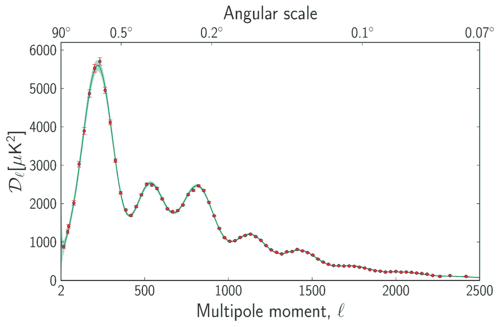It was announced this morning that the WMAP team has won the $3 million Breakthrough Prize. Unlike the Nobel Prize, which infamously is only awarded to three people each year, the Breakthrough Prize was awarded to the whole 27-member WMAP team, led by Chuck Bennett, Gary Hinshaw, Norm Jarosik, Lyman Page, and David Spergel, but including everyone through postdocs and grad students who worked on the project. This is great, and I am happy to send my hearty congratulations to all of them (many of whom I know well and am lucky to count as friends).
I actually knew about the prize last week as I was interviewed by Nature for an article about it. Luckily I didn’t have to keep the secret for long. Although I admit to a little envy, it’s hard to argue that the prize wasn’t deserved. WMAP was ideally placed to solidify the current standard model of cosmology, a Universe dominated by dark matter and dark energy, with strong indications that there was a period of cosmological inflation at very early times, which had several important observational consequences. First, it made the geometry of the Universe — as described by Einstein’s theory of general relativity, which links the contents of the Universe with its shape — flat. Second, it generated the tiny initial seeds which eventually grew into the galaxies that we observe in the Universe today (and the stars and planets within them, of course).
By the time WMAP released its first results in 2003, a series of earlier experiments (including MAXIMA and BOOMERanG, which I had the privilege of being part of) had gone much of the way toward this standard model. Indeed, about ten years one of my Imperial colleagues, Carlo Contaldi, and I wanted to make that comparison explicit, so we used what were then considered fancy Bayesian sampling techniques to combine the data from balloons and ground-based telescopes (which are collectively known as “sub-orbital” experiments) and compare the results to WMAP. We got a plot like the following (which we never published), showing the main quantity that these CMB experiments measure, called the power spectrum (which I’ve discussed in a little more detail here). The horizontal axis corresponds to the size of structures in the map (actually, its inverse, so smaller is to the right) and the vertical axis to how large the the signal is on those scales.

As you can see, the suborbital experiments, en masse, had data at least as good as WMAP on most scales except the very largest (leftmost; this is because you really do need a satellite to see the entire sky) and indeed were able to probe smaller scales than WMAP (to the right). Since then, I’ve had the further privilege of being part of the Planck Satellite team, whose work has superseded all of these, giving much more precise measurements over all of these scales:

Am I jealous? Ok, a little bit.
But it’s also true, perhaps for entirely sociological reasons, that the community is more apt to trust results from a single, monolithic, very expensive satellite than an ensemble of results from a heterogeneous set of balloons and telescopes, run on (comparative!) shoestrings. On the other hand, the overall agreement amongst those experiments, and between them and WMAP, is remarkable.
And that agreement remains remarkable, even if much of the effort of the cosmology community is devoted to understanding the small but significant differences that remain, especially between one monolithic and expensive satellite (WMAP) and another (Planck). Indeed, those “real and serious” (to quote myself) differences would be hard to see even if I plotted them on the same graph. But since both are ostensibly measuring exactly the same thing (the CMB sky), any differences — even those much smaller than the error bars — must be accounted for almost certainly boil down to differences in the analyses or misunderstanding of each team’s own data. Somewhat more interesting are differences between CMB results and measurements of cosmology from other, very different, methods, but that’s a story for another day.
One response to “WMAP Breaks Through”
Hi, I’m a bit puzzled by your comment in the Nature write up that mentioned “systematic errors in one or both experiments”. What conflict could be resolved through a systematic error in WMAP? Planck have claimed that WMAP and Planck temperature power spectra are consistent over the range of scales accessible to both. If that’s true the difference in, for instance, best-fit parameters between WMAP and Planck could not be due to a WMAP systematic. Perhaps I have misunderstood what you meant?